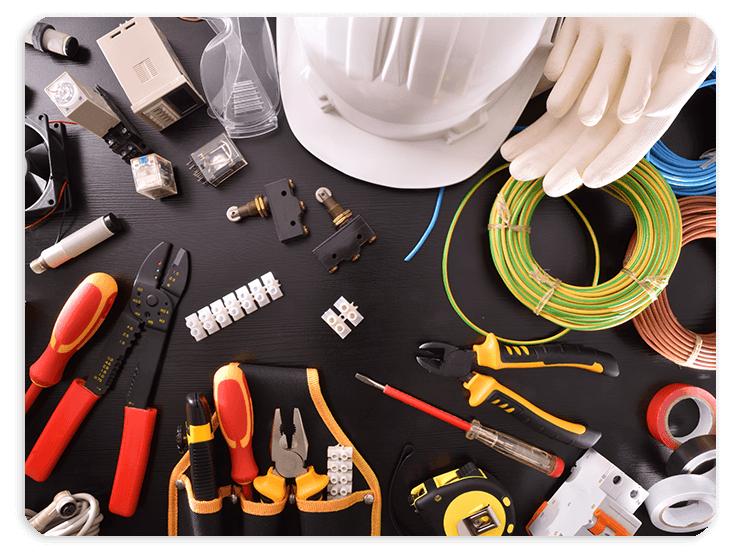Tools & References

Tools

Industry Affiliations
- The National Institute of Standards & Technology’s Hollings Manufacturing Partnership
- National Association of Manufacturers
- National Fire Protection Association
- International Society of Explosives Engineers
- Pyrotechnics Guild International
- Underwriters Laboratories
- The Wire Association International Inc
Glossary
-
A-C
+
AWG
Abbreviation for American Wire Gauge.
AWM
Designation for appliance wiring material. Alternating Current-Electric current that continually reverses its direction. It is expressed in cycles per second (hertz or Hz).
Ambient Temperature
The temperature of the medium (gas, liquid, or earth) surrounding an object.
American Wire Gauge (AWG)
A standard system for designating wire diameter. It is also referred to as the Brown and Sharpe (B&S) wire gauge.
Ampacity
See Current Carrying Capacity.
Ampere
The unit of current. One ampere is the current flowing through one ohm of resistance at one-volt potential.
Anneal
Relief of mechanical stress through the application of heat and gradual cooling. Annealing copper renders it soft and less brittle.
Audio Frequency
The range of frequencies audible to the human ear. Usually 2020,000 Hz.
Braid
A fibrous or metallic group of filaments interwoven in cylindrical form to form a covering over one or more wires.
Breakdown Voltage
The voltage at which the insulation between two conductors breaks down.
Bunch Stranding
A group of wires of the same diameter twisted together without a predetermined pattern.
Cabling
The twisting together of two or more insulated conductors to form a cable.
Capacitance
The ability of a dielectric material between conductors to store electricity when a difference of potential exists between the conductors. The unit of measurement is the farad, which is the capacitance value that will store a charge of one coulomb when a one-volt potential difference exists between the conductors. In AC, one farad is the capacitance value that will permit one ampere of current when the voltage across the capacitor changes at a rate of one volt per second.
Circuit (Electric)
The complete path of an electrical current. When the continuity is broken, it is called an open circuit; when continuity is maintained, it is called a closed circuit.
Cold Flow
Permanent deformation of the insulation due to mechanical force or pressure (not due to heat softening).
Color Code
A system for circuit identification through the use of solid colors and contrasting tracers.
Compound
An insulating or jacketing material made by mixing two or more ingredients.
Concentricity
In a wire or cable, the measurement of the location of the center of the conductor with respect to the geometric center of the surrounding insulation.
Conductor
An uninsulated wire suitable for carrying electrical current.
Contacts
The parts of the connector that carry the electrical current and that touch the equivalent parts in the mating connector.
Continuity Check
A test to determine whether electrical current flows continuously throughout the length of a single wire or individual wires in a cable.
Cord
A flexible insulated cable.
Corona
Ionization of air surrounding a conductor caused by the influence of high voltage. Causes deterioration of insulation materials.
Crazing
The minute cracks on the surface of plastic materials.
CSA
Abbreviation for Canadian Standards Association, a non-profit, independent organization that operates a listing service for electrical and electronic materials and equipment. The Canadian counterpart of the Underwriters Laboratories.
Current Carrying Capacity
The maximum current an insulated conductor can safely carry without exceeding its insulation and jacket temperature limitations. It is dependent on the installation conditions.
-
D-G
+
Decibel (DB)
A unit that expresses differences in power or voltage level. It is used to express power loss in passive circuits or cables.
Dielectric Strength
The voltage that an insulation can withstand before breakdown occurs. Usually expressed as a voltage gradient (such as volts per mil).
Direct Capacitance
The capacitance measured directly from conductor to conductor through a single insulating layer.
Drain Wire
In a cable, the uninsulated wire laid over the shield component or components and used as a ground connection.
Drawing
In wire manufacturing, pulling the metal through a die or series of dies to reduce the diameter to a specified size.
EMI
Abbreviation for electromagnetic interference.
Eccentricity
Like concentricity, a measure of the center of a conductor’s location with respect to the circular cross-section of the insulation. Expressed as a percentage of displacement of one circle within the other.
Elongation
The fractional increase in length of a material stressed in tension.
Farad
A unit of electrical capacitance.
Filler (1)
(1) A material used in multi-conductor cables to occupy large interstices formed by the assembled conductors. (2) An inert substance added to a compound to improve properties or decrease cost.
Flame Resistance
A material’s ability to resist flame propagation once the heat source is removed.
Flex Life
The measurement of the ability of a conductor or cable to withstand repeated bending.
Frequency
The number of times an alternating current repeats its cycle in one second.
G
An industry designation for a 2kV portable power cable consisting of 2 – 4 insulated conductors with ground wires placed in the valleys for use in mines and similar applications.
G-GC
An industry designation for a 2kV portable power cable consisting of 3 insulated conductors with ground wires, 2 ground wires, and a ground check conductor. For use in mines and similar applications.
Gauge
A term used to denote the physical size of a wire.
Ground
An electrical term meaning to connect to the earth or other large conducting body to serve as an earth, thus making a complete electrical circuit.
-
H-L
+
HPD
Heater cord with thermoset insulation and cotton or rayon braid overall.
HPN
Parallel heater cord.
Harness
An arrangement of wires and cables, usually with many breakouts, which have been tied together or pulled into a rubber or plastic sheath, used to interconnect an electric circuit.
Hertz (HZ)
A term replacing cycles-per-second as an indication of frequency.
Hi-pot
A test designed to determine the highest voltage that can be applied to a conductor without breaking through the insulation.
HZ
Abbreviation for hertz.
Impedance
The total opposition a circuit offers to the flow of alternating current or any other varying current at a particular frequency. It is a combination of resistance R and reactance X, measured in ohms.
Inductance
The property of a circuit or circuit element that opposes a change in current flow, thus causing current changes to lag behind voltage changes. It is measured in henrys.
Insulation
A material having high resistance to the flow of electric current. Often called a dielectric in radio frequency cable.
Jackets
An outer non-metallic protective covering applied over an insulated wire or cable.
Jumper Cable
A short flat cable interconnecting two wiring boards or devices.
Lay
The length measured along the axis of a wire or cable required for a single strand (in stranded wire) or conductor (in cable) to make one complete turn about the axis of the conductor or cable.
Longitudinal Shield
A tape shield, flat or corrugated, applied longitudinally with the axis of the core being shielded.
-
M-Q
+
HPD
Heater cord with thermoset insulation and cotton or rayon braid overall.
HPN
Parallel heater cord.
Harness
An arrangement of wires and cables, usually with many breakouts, which have been tied together or pulled into a rubber or plastic sheath, used to interconnect an electric circuit.
Hertz (HZ)
A term replacing cycles-per-second as an indication of frequency.
Hi-pot
A test designed to determine the highest voltage that can be applied to a conductor without breaking through the insulation.
HZ
Abbreviation for hertz.
Impedance
The total opposition a circuit offers to the flow of alternating current or any other varying current at a particular frequency. It is a combination of resistance R and reactance X, measured in ohms.
Inductance
The property of a circuit or circuit element that opposes a change in current flow, thus causing current changes to lag behind voltage changes. It is measured in henrys.
Insulation
A material having high resistance to the flow of electric current. Often called a dielectric in radio frequency cable.
Jackets
An outer non-metallic protective covering applied over an insulated wire or cable.
Jumper Cable
A short flat cable interconnecting two wiring boards or devices.
Lay
The length measured along the axis of a wire or cable required for a single strand (in stranded wire) or conductor (in cable) to make one complete turn about the axis of the conductor or cable.
Longitudinal Shield
A tape shield, flat or corrugated, applied longitudinally with the axis of the core being shielded.
-
R-S
+
Rated Voltage
The maximum voltage at which an electrical component can operate for extended periods without undue degradation or safety hazard.
REA
Abbreviation for Rural Electrification Administration, which is part of the U.S. Dept. of Agriculture. REA establishes specifications and provides approval for telephone station wires and power cables.
Resistance
A measure of the difficulty moving electrical current through a medium when voltage is applied. It is measured in ohms.
RFI
Abbreviation for radio frequency interference.
S
Heavy-duty, rubber-insulated portable cord. Standard copper conductors with separator and individual rubber insulation. Two or more color-coded conductors cabled with filler, wrapped with separator and rubber jacketed overall 600V.
SEO
Same construction as STO, except the insulation and jacket are made of Thermoplastic Elastomer Rubber (TPE) 600V.
SEOW
Same construction as SEO, except it is suitable for outdoor use. Usually UL listed for continuous submersion in water 600V.
SEOOW
Same construction as SEOW, except with oil-resistant insulation.
SJ
Junior hard service rubber-insulated pendant or portable cord. Same construction as SJT except the insulation and jacket are thermoset (rubber) 300V.
SJEO
Same construction as SJT, except the insulation and jacket are made of Thermoplastic.
SJEOW
Same construction as SEOW except 300 volt rated.
SJO
Same as SJ, but an oil-resistant outer jacket. Can also be made “water resistant.” 300V, 60°C, 75°C, 90°C or 105°C.
SJOOW
Same as SOOW except 300 volt rated.
SJT
Junior hard service thermoplastic conductors with an overall thermoplastic jacket, 300V, 60°C, 75°C, 90°C or 105°C.
SJTO
Same as SJT, but an oil-resistant thermoplastic outer jacket.
SLC
Stage Lighting Cable. A 600-volt single conductor cable for indoor and outdoor stages, fairs, and carnivals.
SO
Hard service cord. Same construction as type S, except for the oil-resistant thermoset jacket. 600V, 60°C to 105°C.
SOW
Same as SO except suitable for outdoor use.
SOOW
Same as SOW except for oil-resistant insulation.
SP-1
All rubber, parallel-jacketed, two-conductor light-duty cord for pendant or portable use. 300V.
SP-2
Same as SP-1, but with heavier construction, with or without a third conductor for grounding purposes. 300V.
SP-3
Same as SP-2, but heavier construction for refrigerators or room air conditioners. 300V.
SPE
Same construction as SP-1, except the insulation and jacket are made of Thermoplastic Elastomer Rubber (TPE).
SPT-1
Same as SP-1, except all-thermoplastic, 300V. With or without a third conductor for grounding.
SPT-2
Same as SP-2, except all-thermoplastic. 300V. with or without a third conductor for grounding.
SPT-3
Same as SP-3, except all-thermoplastic. 300V. with or without a third conductor for grounding.
ST
Hard service cord, jacketed. Same as type S, except for all-plastic construction. 600V, 60°C to 105°C.
STO
Same as ST, but with an oil-resistant thermoplastic outer jacket. 600V, 60°C to 105°C.
SV
Vacuum cleaner cord, rubber-insulated with rubber jacket, rated at 300V.
SVE
Same construction as SV, except insulation and jacket made of Thermoplastic Elastomer (TPE).
SVT
Same as SV, except for all-plastic construction. With or without a third conductor for grounding purposes only. 300V, 60°C to 105°C.
Separator
Pertaining to wire and cable, a layer of insulating material such as textile paper, Mylar, etc., is placed between a conductor and its dielectric, between a cable jacket and the components it covers, or between various components of multiple conductor cables. It can be utilized to improve stripping qualities and/or flexibility, or can offer additional mechanical or electrical protection to the components it separates.
Shield
A tape serve, or braid of metal, usually copper, aluminum, or other conducting material, placed around or between electric circuits or cables or their components to contain any unwanted radiation or to keep out unwanted interference.
Spacing
Distance between the closest edges of two adjacent conductors.
Spark Test
A test designed to locate pinholes in the insulation of a wire or cable by application of a voltage for a very short period of time while the wire is being drawn through a field of electrodes.
Spiral Wrap
The helical wrap of a tape or other material over a core or component.
Strand
A single uninsulated wire.
Stranded Conductor
A conductor composed of wires or groups of wires twisted together.
Surge
A temporary and relatively large increase in the voltage or current in an electric circuit or cable. Also called a transient.
-
T-Z
+
TC-Tray Cable
Multi-conductor cable specifically approved for use installed in cable trays.
Tensile Strength
The pull stress required to break a given specimen.
Thermoplastic
A material that softens and melts when heated and becomes firm on cooling.
Thermoset
A material that hardens or sets when heat is applied and that, once set, cannot be softened by heating. The application of heat cures or vulcanizes the material.
TPE
Abbreviation for Thermoplastic elastomer.
UL
Abbreviation for Underwriters Laboratories, a non-profit independent organization that operates a listing service for electrical and electronic materials and equipment.
Voltage
The term most often used in place of electromotive force, potential, potential difference, or voltage drop to designate the electrical pressure that exists between two points and is capable of producing a current when a closed circuit is connected between two points.
VW
1-A flammability rating established by Underwriters Laboratories for wires and cables that pass a specific vertical flame test, formerly designated FR-1.
W
UL designation for outdoor listed flexible cord tested for sunlight and weather requirements (e.g., STW).
W (TYPE)
An industry designation for a 2kV portable power cable consisting of 1 6 insulated conductors. For use in mines and similar severe duty applications.
Water-Resistant
UL designation for cords with insulation on the individual conductors that pass UL requirements (e.g., ST Water Resistant or ST Dry 105°C, Water Resistant 60°C).





